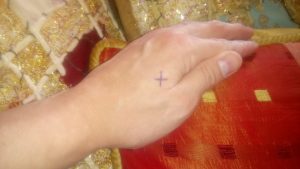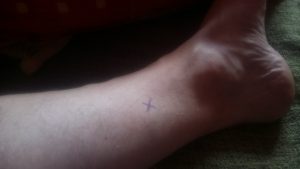


LABOUR ACUPRESSURE
Labour acupressure seems to be more effective than the use of needles with regard to providing pain relief and to help facilitate efficient labour. Acupuncturists with active experience in this field report women experiencing pain reduction combined with a sense of calmness and satisfaction with their own experience of giving birth.
There are numerous acupuncture points that can be used in labour acupressure. I think that these are among the best ones:
Large Intestine 4 (He Gu): to enhance efficiency of contractions, for pain relief, to promote placental delivery, to promote an effective second stage of labour, and to minimise blood loss in the third stage of labour. To locate, squeeze the thumb against the base of the index finger and find this point at the highest point of the bulge of muscle.

Labour acupressure point Large Intestine 4 (He Gu)
Spleen 6 (San Yin Jiao): to promote labour and cervical dilation. An ache in the cervix or an ache travelling up the inside of the leg are normally interpreted as signs that this point is working. To locate this point, find it approximately one hand-width superior to the most prominent part of the medial ankle and approximately hand a finger’s width or less from the shin.

Labour acupressure point Spleen 6
Liver 3 (Tai Chong)): this can be used to aid dilation or when labour fails to progress effectively. It is particularly beneficial for anxious, fearful women or when external factors are impacting emotionally to reduce the effectiveness of labour. Locate on the top of the foot in a tender depression between the tendons that run towards the big and second toe.
Bladder 32 (Ci Liao): good for pain relief, particularly pain that presents in the lumbar area. It also helps to promote efficient labour and aids cervical dilation. This is in the sacral area of the back (the triangular lowest part of the backbone at the pelvic level). It can be hard to locate exactly, so pressure to any sensitive points in the sacral area, possibly in downward strokes, is the most practical way to approach this.
Bladder 67 (Zhi Yin): this is the same point that can be used in late-stage pregnancy to turn a breech presentation. It can be used when the baby is in a posterior position, which can lead to failure for labour to progress. Locate on the side of the little toe where lines from the lateral side border of the nail and the proximal border of the nail would meet.
Gall Bladder 21 (Jian Jing): to help the baby descend and for pain. Also good to promote placental delivery. This is located at the midpoint of the height of the trapezius muscle, which runs from the neck to the shoulder.
It is important that labour acupressure be started as soon as possible before the most intense stages of labour. A partner or support person will be required, who should be adequately versed in the location and application of these points. Beginning labour acupressure once contractions are already beginning to feel unmanageable is likely to be too late to have any effect.
It should also be stated that in very short labour with very intense contractions from the start, labour acupressure is unlikely to be effective.
Once acupressure started, the woman needs to decide which points are most helpful. This will vary from one to another and may vary as labour progresses. A point should not be used if it produces discomfort (except SP6 for delayed, prolonged, difficult labour rather than pain) and should produce a pleasant sensation or effect.
Many midwives are familiar with labour acupressure techniques. A few years ago, while travelling in southern Africa I met a French midwife who explained that in her country, she and her fellow professionals routinely used these points. Later on the trip, while staying in a small village, she actually put this into use when asked to help with a difficult delivery for a local woman in the absence of any other medical aid. Midwives most commonly use acupressure on the Large Intestine 4 point when the cervix is dilated and the baby is in the birth canal but there is inefficient pushing.
To find out more about how acupuncture may be used when certain issues occur during pregnancy, take a look at this page: http://www.londonacupuncturetherapy.co.uk/conditions/
It will be obvious to the woman and to the midwife and medical team if labour acupressure is working to promote labour and provide pain relief. Medical intervention should never be refused if required.
Further information about pain relief during childbirth can be found here: https://www.nct.org.uk/birth/pain-relief-during-labour


